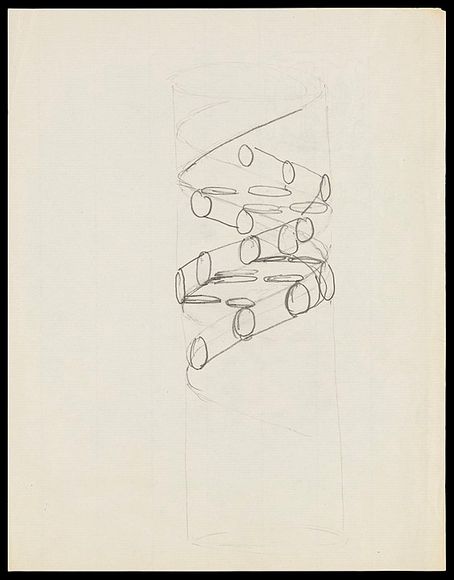Author: Silvia Marinova, PhD student in the Genomic Stability Laboratory at BAS
In this article we will get acquainted with perhaps the most important biomolecules that are the key to longevity. They carry encoded information that is passed from parents to children and determines the hereditary characteristics of all living organisms. And yes, if DNA is popping into your mind right now, then you're absolutely right.
DNA belongs to the class of these biomolecules, called, as you guessed from the title, nucleic acids. They deserve special attention and in the text below we will focus on their chemical properties, which make them a suitable "memory card" for our hereditary information. We will also take a look at the fascinating mechanisms by which this happens and you will understand why we can safely say that the nucleic acids are the conductors of our lives.
A brief history of nucleic acids
This section is not intended to bore you, but only to illustrate the path that passes the idea of heredity from the not-so-distant past to theday.
- 1866 - Gregor Mendel published his original work, in which he laid out the basic principles by which traits are passed down through generations . Today, perceived as the father of genetics, his research provokes a small dose ofskepticism, and it will take years to rediscover them.
- 1869 - Friedrich Misher isolated the first DNA from the nuclei of white blood cells and therefore called it "nuclein" (nucleus = nucleus).
- 1944 Oswald Avery was the first to make the connection between heredity and DNA.
- 1955 - Irwin Chargaff finds that DNA differs in composition in different organisms and lays down rules for the composition of its building units.
- 1952 Rosalind Franklin gets a radiographic shot of strands of DNA.
- 1953 Watson and Crick deciphered the double-chain structure of DNA, for which they were awarded the Nobel Prize.

A sketch of DNA drawn with a pencil by Francis Crick in 1953. Wikipedia
Since then, numerous discoveries - related to them and genetics - have continued to be made that show us how vast a universelies within us.
Types of nucleic acids and their role in cells
The two main classes of nucleic acids are deoxyribonulecin acids (DNA) and ribonukelenic acids (RNA). Other viruses use RNA as a matrix for their inherited information, but moreover, RNA is also found in all living organisms, as it performs many important functions, the main of which is the reliance on genetic code (DNA) and protein production . If the last sentence has not become completely clearto you, do not worry, but continue reading. :)
DNA → RNA → Protein
- DNA - it plays the role of a "memory card" in our cells - contains our genetic code with instructions for all the functions of our cells.
- RNA - has a variety of types of RNA with essential functions, but 3 are the most basic types. For now, we will mention only information RNA (RNA).
- Protein - this is the final functional product (details can be found here), which is built from ribosomes, after they read the RNA carrier of genetic information through the translationprocess.

Comparison between DNA and RNA. Wikipedia
However, it is important to stress that the presentation is a very simple version of the actual processes that are taking place.
Now that we have figured out in what direction the information flow in the cell is going, let's head to the chemical structure of NK. Of course, again in a simplified version, so do not be :)
Nucleic acids are made of nucleotides
Nucleic acids are polynucleotides - this means long polymer molecules similar to a chain, which are made up of repetitive almost identical building blocks (monomers) - nukeotides .
- Nitrogen base - this is an organic structure that forms a ring and contains in itself the chemical element nitrogen N. Nitrogen bases are 5 types - adenine (A), tamine (T), cytosin (C), guanine (D) and uracyl (Y). Each SP is made up of sequences with 4 types of nitrogen bases. DNA contains A, T, C and D.
- Pentosis is a five-carbon sugar . In DNA it is called deoxyribose, and in RNA - ribose. The difference between the two is that deoxyribose contains one -OH group less thanthe ribose of 2' position (marked in the figure).
- Phosphate - nucleotides in the RNA chain or DNA have one phosphate group, which binds the 3' ON group of pentosis from one nucleotide to the 5' ON group of pentosis from the next nucleotide, etc. This connection is known as phosphodiester bond and is necessary for the construction of polynucleotide chains of single nucleotides.
Main characteristics of DNA
DNA is a long polynucleotide chain that formsa double-chain spiral structure . And it is always paired with A through two hydrogen bonds, and D is always paired with A through three hydrogen bonds. This structure, together with the stability of the molecule, makes DNA the most appropriate carrier of our genetic information.
Main features of RNA
RNA from its joint is usually composed of asingle chain .It is less stable than DNA and therefore is not preferred as the main carrier of the genetic material. It is also a polynucleotide chain, but contains A, Y (instead of T), D and C. Performs multiple roles in the cell, but one of the mostbasic is the participation in the rewriting of parts of the genetic code (transcription) when needed.
Summary of differences between RNA and DNA

With this article, we have laid the groundwork for the next topic in which we will find out what science genetics is doing . Themost important thing to remember is that DNA is the carrier of hereditary information. RNA uses this genetic code as an intermediary between it and the functional tools of the cell - proteins.
Read more:
Epigenetics or how lifestyle governs our genes
